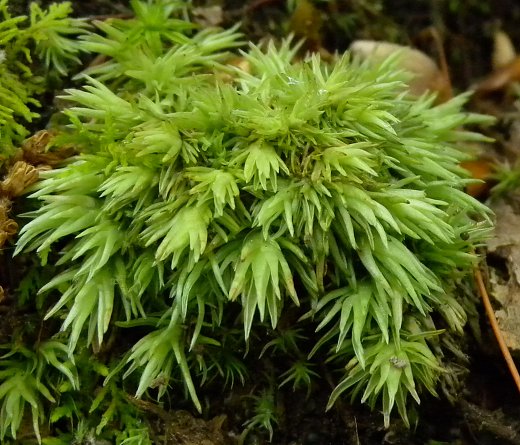
The tiny spores are released to the wind; this typically occurs during autumn or early winter. Individual spores are 13-18 micrometers across, globoid in shape, and either smooth or finely warty. Fibrous rhizoids are produced at the base of each plant in order to anchor it to the underlying substrate. This moss is capable of reproducing asexually when its dry leaves are broken off as a result of disturbance. With the return of moisture, such leaves are capable of forming their own fibrous rhizoids, starting the development of new clonal plants. When a cushion of this moss is overturned from some kind of disturbance, the leaves lying against the ground are able to develop new fibrous rhizoids to anchor the entire cushion to the ground.
Cultivation: The preference is medium shade to partial sun, moist to dry-mesic conditions, and an acidic soil containing humus, clay, sand, gravel, or rocky material. This moss is able to tolerate drier conditions than most mosses. At favorable sites, it can be long-lived for a moss, forming sizable cushions of plants.
Range & Habitat: The native Pincushion Moss (Leucobryum glaucum) is occasional in Illinois, occurring in most areas of the state, although it has not been reported from its NW and SW sections (see Distribution Map). This moss is widely distributed in eastern North America and Europe. In Illinois, habitats include the ground of rocky woodlands, shaded hillsides, wooded bluffs and ridges, well-rotted pine logs in sandy savannas, sandstone cliffs and ledges, sandstone walls along streams, cemetery grounds, lightly shaded ground in city parks, areas adjacent to large buildings, and clay banks along roadsides. Pincushion Moss is often found in upland habitats where oak trees are dominant, and it has a tendency to co-occur with such mosses as Dicranum scoparium (Windswept Broom Moss) and Polytrichastrum ohioense (Ohio Haircap Moss). While this moss usually occurs in high quality natural areas, it is occasionally seen in disturbed habitats.

Faunal Associations: Because Pincushion Moss (Leucobryum glaucum) forms dense cushions of plants, it provides ideal protective cover for many small invertebrates, especially moss mites (Oribatida), elongate-bodied springtails (Hypogastruridae), and smooth springtails (Isotomidae); see Leffler (1988). Some of these insects specialize in feeding on this and other mosses. However, Pincushion Moss contains one or more toxic substances that deter its consumption by some polyphagous insects, such as the larvae of the moth, Trichoplusia ni (Cabbage Looper). For this reason, it may be useful in the creation of a new insecticide (Haines & Renwick, 2009). Various vertebrate animals sometimes overturn cushions of this moss and move them around during their search for food; this includes birds (especially crows), chipmunks, and tree squirrels. This moss is adapted to such disruption because it is able to develop rhizoids from its leaves, enabling it to re-anchor itself to the ground or start new clonal plants (Glime, 2017). Another vertebrate animal, Plethodon cinereus (Eastern Red-backed Salamander), has been found hiding in cushions of this moss (Glime & Boelema, 2017).
Photographic Location: A rocky upland woodland above a sandstone ravine at the Portland Arch Nature Preserve in west-central Indiana, and along the slope of a sandstone ravine at the same park.
Comments: This is a very attractive moss that forms dense cushions of plants of variable size. Large cushions of plants, in particular, have an impressive and somewhat exotic appearance. Pincushion Moss (Leucobryum glaucum) is the most common species of its genus in Illinois. It can be confused with another species, White Moss (Leucobryum albidum), which has a similar appearance. This latter moss can be distinguished by the smaller size of its colonies (typically 2" across or less) and the smaller size of its leaves (typically 3-5 mm. long). The broad bases of its leaves extend to about one-half of their length, while the broad bases of the leaves of Pincushion Moss extend to be what one-third of their length. The leaves of White Moss are less thick (typically 3 cells deep) than those of Pincushion Moss (4-6 cells deep), making the latter moss more resistant to dessication.